#but this was during the original final battle on the zenith island
Explore tagged Tumblr posts
Photo
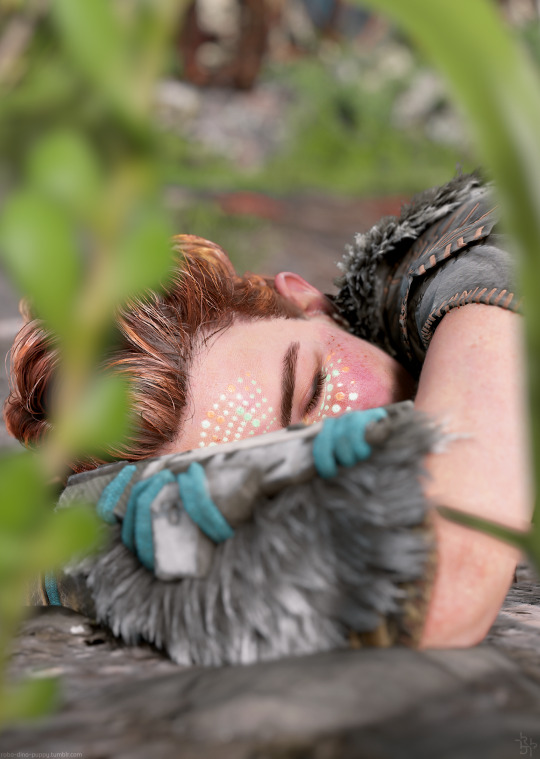
let the girl nap
#horizon forbidden west#hfw#aloy#ok she's just on the ground and she was knocked there by a machine#but still#she deserves a nap#there was some real funky light on her skin#i've never seen it before - almost like a grid pattern?#i think i did an ok job of getting rid of it tho#this is queued (like most of my posts)#so hopefully by now i'll have played some of the dlc#but this was during the original final battle on the zenith island#she got knocked down by a specter while i was trying to take pics of my allies lol
83 notes
·
View notes
Text
Literally can't stop thinking about "You have indeed felt a great loss. But love is a form of energy, and it swirls all around us. The Air Nomads' love for you has not left this world. It is still inside of your heart, and is reborn in the form of new love" and how much the concept of this quote pretty much applies to the main characters within atla, especially in regards to their development and central arcs throughout the series and how it plays a big role in their journey, either on a large scale or a more subtle one.
Aang's is the most obvious and is the original context of this quote. His love for the Air Nomads and their love for him is reborn in his love for Katara and vice versa. These two develop an instinctual bond as soon as they meet and get along very well, providing each other with support in overcoming the trauma, a listening ear when things are rough or standing up for the other when they encounter obstacles, especially ones related to their bending. They supply each other with the home and understanding that has been lost as a result of the war. Aang's love for Sokka can be interpreted in the same way, who forms one of the first bases for Aang's second family after the loss of his entire culture. It's not just that though, there's also the gradual trust in each other's leadership skills, reaching its zenith in their preparations for the invasion of the Fire Nation capital.
Katara's reborn love is likewise Aang's as well, and I think the best way to demonstrate this example is paralleling Aang's actions in the second episode of book one when Zuko and his crew attacked the South Pole and Kya's in the flashbacks of the Southern Raiders. Both are people who meant a lot for Katara and who at that point helped in shaping her view of the world, since Kya raised her and Aang even in the short span they interacted reminded her of the joy of enjoying her adolescence and having fun. Both did not hesitate to offer themselves up for the Fire Nation when it became clear that Katara and the village was in danger and both made a conscious effort to reassure Katara during those sequence of events. Of course, Aang and Kya didn't have the same outcome but that's not the point.
Zuko's is Ursa's and Iroh's. It's not a reborn love in the literal sense but for all intents and purposes, the result is largely similar. While we know from flashbacks that Zuko was very close to his uncle even prior to Iroh losing his son and events leading up to Zuko's banishment, the fact of the matter is that Ursa is shown to be his primary caregiver, the person who works to do whatever they can to shield him from Ozai's abuse and someone who inspires a lot of his conceptions about his self image, particularly his persistence in the face of adversity and failure. Once Ursa is no longer in a position to continue doing so, that role is then taken up by Iroh who continuously makes every effort he can to support Zuko through the worst period of his life, providing the love and care he needs in order to heal, standing against the harm Azula and Ozai attempt to inflict against him (often literally) as well as teaching him the tools he needs in order to continue building his separate identity outside of the toxic ideals of his family. Whether that is in relation to Zuko's bending and the way he's been branded as the less talented and therefore a disappointment or in relation to the imperialist mindset of their country and the royal family by passing on the ideals that Iroh himself learned through his journey of self-reflection.
Sokka actually has two forms of reborn loves, which I realised upon some extensive thinking. The first is by far the more obvious, which is Yue and Suki. Yes, Sokka met Suki first but the order of events lend my argument some weight. It's not just that both are his primary love interests (which they are) but they are ones who influenced Sokka's relationship to his role as a protector and to another extent they were people who he could enjoy himself around on more equal terms since he more often than not is the 'plan guy' within the gaang. Yue's death and his inability to do anything that prevents it enhances his overprotective tendencies and it's no coincidence that he faces this particular issue with Suki on the serpent's pass by his own admission. He's later able to overcome it and start a relationship with Suki without the shadow of that incident hanging down on them (pardon the pun). The other one, which is more subtler and might puzzle some, is Hakoda and Piandao. Hakoda as Sokka's father is his role model, the ideal of the warrior that he strives to live up to and who reassures him of his worth and his pride in him. This guidance is also, to a degree, the part that Piandao plays as his mentor; he helps Sokka gain the confidence needed in himself and imparts lessons that tie in to skills as a warrior. In each of the episodes "Sokka's Master" and "The Guru", Sokka experiences low faith in his abilities and is reassured by Piandao and Hakoda respectively (although Piandao's was much more... confrontational). In the end, the purpose is served. Hakoda cannot be present with the amount that Sokka needs but the love he has for him is found in a new shape in Piandao's mentorship.
Toph experiences her first unconditional love during her childhood with the badger-moles, they are the creatures who accept her and her blindness and they're the ones with whom she gains faith in her earthbending. That love is carried over when she meets Team Avatar, Aang challenges the double identity she built in her life that is in conflict of the image her parents have of her, "the obedient little helpless blind girl", and she decides later to leave her home behind and take a leap of faith so to speak. This decision leads her to be able to build healthy relationships where she's comfortable and secure. Katara teaches her that expressions of femininity and her tough persona don't have to be at odds with each other, and that she can enjoy being pampered and still at the end of the day resume acting herself. And we have many instances where Sokka leads Toph around in places where she needs someone to help her to and Toph is comfortable doing so. It's a development from the Toph we first meet, who rejects aid because she needs to establish her own personhood. She grows to be okay with relying on others in a way that doesn't lessen her own independence.
Suki admittedly gave me a bit of a brain scratcher until I drew upon her biggest relationships, the Kyoshi Warriors and Sokka. Suki is the leader of the group, she's someone who believes in herself and knows her capabilities very well and it's not hard to understand that it's because of her position as Kyoshi Warrior. But more importantly, her fellow comrades offer her a support net. She can rely on them to have her back, just as they did during the attack on Kyoshi Island and in the Earth Kingdom. And after the run in with Azula, Mai and Ty Lee and getting separated in imprisonment, she lost that. Her confinement was isolated from any familiar faces and probably very traumatic. Until Sokka finds her in the Boiling Rock, and she regains the lost sense of partnership. From there until the finale, Sokka and Suki are shown to interact romantically, socially and on the battlefield. They joke and have ridiculous fun together while enjoying the Boy in the Iceberg play and they fight together seamlessly on the gondola, during training on Ember Island and in the Airship battle. This is a testament to the incredible trust they built and the camaraderie they share.
Note that when I say reborn, I don't necessarily mean in strict terms of life and death, which can be applied to more than one character anyway, or in the literal sense of reincarnation. I mean it more as a metaphor, it's a love that has been lost or can not present right now, either temporarily or in a more permanent sense. And I think that is one of the most profound messages the show can impart to such a wide audience. That love is a form of energy around us and even though the person who provided us with that specific kind of love isn't or can't be around anymore to give it to us, their love is so strong that it changes and comes back in a new love. It's not gone, not forever, it's just... different.
#aang#katara#zuko#sokka#toph beifong#suki#iroh#atla meta#atla#avatar the last airbender#team avatar#mymeta#meta#ngl i feel like i stopped making sense half way through
73 notes
·
View notes
Text
Greece: A historical essay - Part 1/4
On the 25th of March 2021, the people of Greece celebrate their independence day. This year is especially important because it is exactly 200 years since the outbreak of the revolution (1821). I decided to honor my country and its history with a (relatively) detailed post.
Most people around the world already have knowledge regarding ancient Greece, so I will be brief here.
ANCIENT AND ARCHAIC GREECE:
between 3000 and 1100 B.C. roughly, there existed the Minoan civilization of Crete. We know little about them besides their elaborate palaces (anaktora), intricate plumbing systems and wonderful frescoes. They used the linear A in their writing, which remains undeciphered to this day. This civilization was one which traded with the outside world. Being an island, they also did not have many fortifications, which might have contributed to their downfall. There are 2 main theories as to their decline: Invasions from the mainland Mycenaeans or the major volcanic eruption of Santorini around that time.
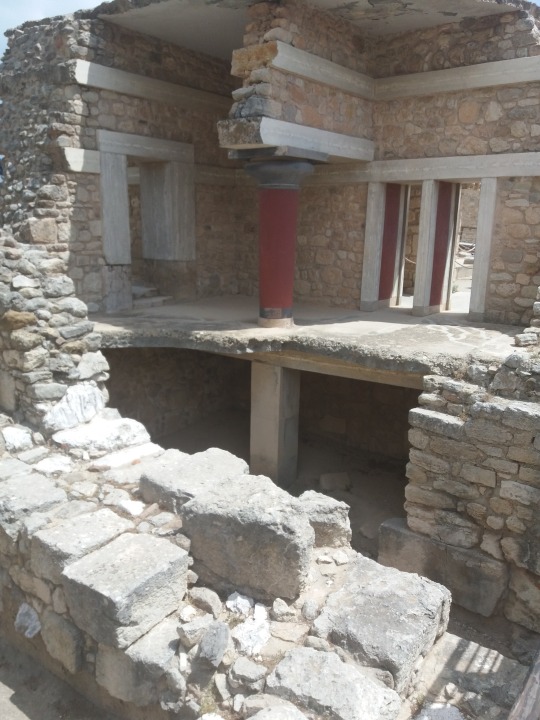
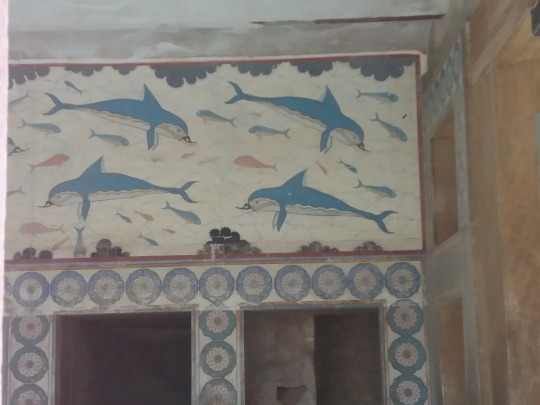
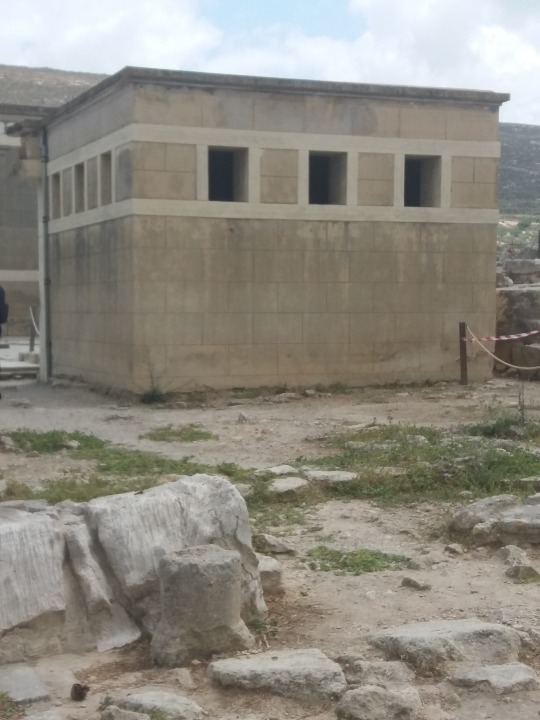

Pictured above: 1) a partially destroyed room, allowing a peek inside 2) some restored frescoes 3) an outer room 4) A showcase of the simple and geometric, yet elaborate and colorful, structure of the building. All of these pictures are from the Palace of Knossos.
The next civilization to succeed them were the aforementioned Mycenaeans, who thrived between 1650 and 1200 B.C. They originally lived in the Peloponnese peninsula, on the southern tips of mainland Greece. It appears that they invaded and subjugated the Minoans at some point. They used linear B for their alphabet, which has successfully been deciphered and is our first indication of archaic or proto-Greek. The later tales of Homer (Odyssey and Iliad) are set in the 1200s and involve Mycenaean legendary heroes and rulers.
They were organized in independent and semi-independent city-state kingdoms, crafted bronze weapons and were a war-like people. Around 1200, we see an increase in fortifications around their settlements and the remains of their palaces carry signs of having been burned. This implies that they, too, fell to an invading force which had been threatening them.
The Minoans and Mycenaeans appear to have both used a centralized “manorial” or palatial economic system, which revolved around their grand palaces.
After their fall came the dark age of ancient Greece, which lasted from 1100 to 750 B.C. As implied by the name, we have very little information about this time. Pottery lost its elaborate design and became merely geometric, the linear B alphabet stopped being used, settlements were much smaller and fewer in population.
One other notable involvement is the arrival of the Doric tribes to the Greek mainland, displacing and possibly mixing with the Mycenaeans.
CLASSICAL GREECE:
This is the ancient Greece everyone knows and loves. The Dorians were not the only ethnic group of that time, with them appeared the Ionians, Achaeans, and Aeolians. In myth, these are all relatives who came from the same ancestor, Hellen (not the famous Helen of Troy, but instead a male patriarch from Thessaly).
The Achaeans might have had a relation to the Myceneans or have existed alongside them to some degree, This is only a hypothesis though.
The Dorians were the direct ancestors of the Spartans and Corinthians, among other smaller states of the Peloponnese.
The Ionians are best remembered as the ancestors of the the Athenians but also their many coastal and islander allies, including the region of Ionia (modern Smyrna/Izmir region) in Asia Minor.
The Aeolians lived in modern-day Thessaly and were the most numerous of the Greek groups. During the Doric invasion, some of them fled to the island of Lesbos and the region of Aeolis (which they named) in Asia Minor.
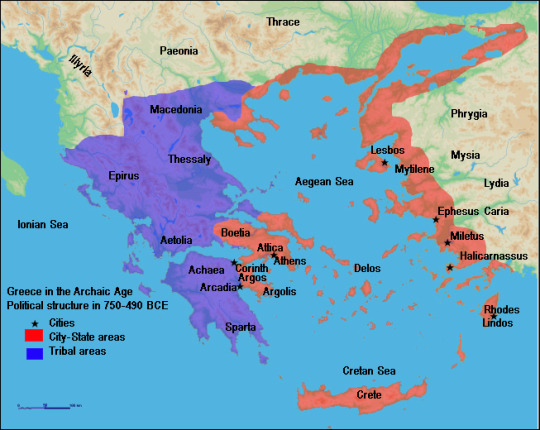
During this period we see the early foundations of what would evolve into the ancient Greek city-state model, as most imagine it, as well as the government forms of Classical Greece - Oligarchy, Democracy, Tyranny. These forms of government acted as ancient ideologies of sorts, to a degree.
In Sparta, Lycurgus implemented the reforms which led to the highly militarized, disciplined, regimented and isolationist Spartans of the Classical period.
In Athens, there was a succession of reformers who led to the establishment of Democracy. First was Dracon, the least democratic of all and whose laws give us the modern definition of the word “Draconic”, afterwards we have the moderate Solon, who can be credited with the foundations of Democracy and maintaining a balance between the aristocratic wealthy and the common poor. There was a brief interruption to democracy between 561 - 510 B.C. as the leader of the Democratic faction, Peisistratus, took the reins of power as a Tyrant (back then, the word had a neutral or even slightly positive connotation, along the lines of “benevolent dictator/enlightened autocrat). The laws and customs of Athenian Democracy were kept in place during those years and were able to blossom after the end of the tyranny. Cleisthenes was the next in the line of reformers. A radical democrat, he greatly expanded the power of the poorer citizens. All of these reforms led directly to the Athenian Democracy inherited by Pericles right before the Peloponnesian war and during the zenith of Athenian power, wealth and culture through its leadership of the Delian League.
Before that though, there were the Persian wars, which started when the coastal city-states and former colonies of Asia Minor cried for help to the Greek mainland, in an effort to avoid complete annexation by the Persian empire.
This led Greece to band together against the threat of the Persians and beat them back, after many losses and much hardship. This is considered the main grand epoch of the classical era and bound them all together as “Hellenes” for the first time.
Greece was not a place of long-lasting peace and alliances though. Soon after, the Athenian populist democratic politicians promised their people great opulence, which they could only ensure by taking from the common fund of the Delian League and using that money on their city. Thus Athens prospered at the expense of its supposed allies, leading to the era of Athenian Hegemony around the 5th century B.C. (Sparta used to be the hegemon before them, around 650 B.C.). This all lead directly to the Peloponnesian war of 431 - 404, where the Spartans emerged victorious after protracted campaigns and battles, gaining the title of “liberators” for dismantling the Athenian hegemony and liberating their tributaries.
During this period we also have the beginning of Greek philosophy as we know it, with the activity of Socrates. Pre-Socratic philosophers were generally natural scientists and cosmologists, he was the first to deal with moral and political philosophy, changing the term forever. Plato was his student, who famously wrote his own political system in “The republic” and unsuccessfully tried to implement it in Syracuse. Aristotle was the student of Plato and became the founder of Mixed government and Classical republicanism (as it was later known and developed later in the renaissance), he was also the teacher of Alexander the Great, the famous Greek-Macedonian king who created an empire.
Sparta’s attempt at aiding oligarchic tyranny in Athens, with the conclusion of the war, failed and Athens returned back, somewhat weak but still great, after only a few years. The next hegemon to take the title were the Thebans, the third most powerful city-state of the era. They held it for a short while in the 3rd century, until Alexander the Great’s father, Philip II, took that title from them, laying the groundwork for the later conquests of his son.
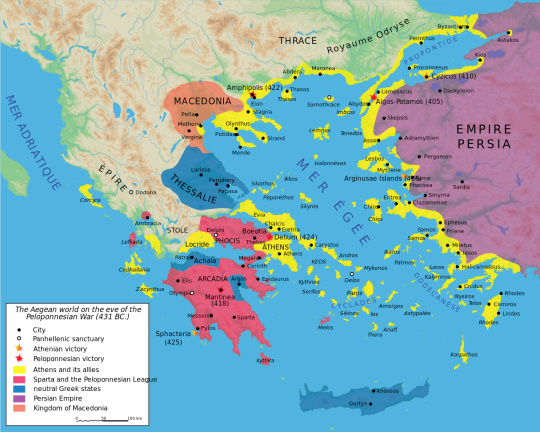
Alexander defeated the Persians, conquered Egypt, Babylon, Asia minor, Persia itself and finally modern-day Pakistan and Afghanistan, reaching the Indus river, where he finally met his equal at the hands an Indian kingdom and was forced to return back to Babylon, where he died.
His empire fractured into four successor states and Rome met little resistance, fighting only Epirus and a weakened Macedon, in their conquest of Greece.
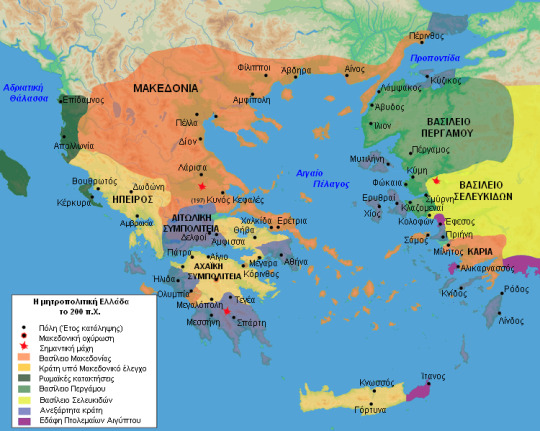
Pictured above: Greek states around 200 B.C.
Bright yellow: Seleucids
other Yellow: Achaean League, Epirus and states under Macedonian influence
Dark Blue: Aetolian League and Independent states
Orange: Macedon
Dark Green: early Roman conquests
Light Green: Kingdom of Pergamum
Purple: Ptolemaic (Egyptian) holdings
11 notes
·
View notes
Text
Portugal 2nd Dynasty: House of Aviz
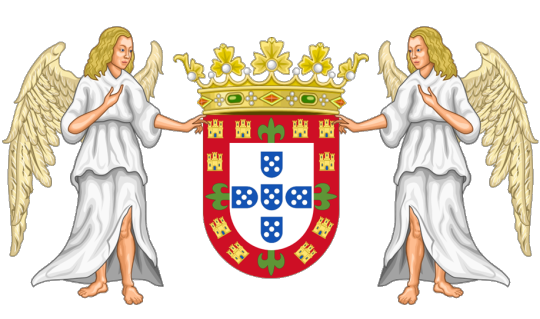
The House of Aviz (Casa de Avis), also known as the Joanine Dynasty (Dinastia Joanina), was a dynasty of Portuguese origin which flourished during the Renaissance and the period of the Portuguese discoveries, when Portugal expanded its power globally.
The house was founded by King João I of Portugal,

Grand-Master of the Order of Aviz and illegitimate son of King Pedro I (of the Portuguese House of Burgundy),
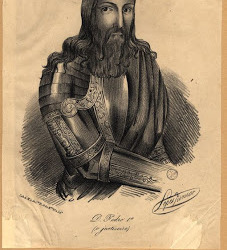
who ascended to the throne after successfully pressing his claim during the 1383–1385 Portuguese interregnum. Aviz monarchs would rule Portugal through the Age of Discovery, establishing Portugal as a global power following the creation of the Portuguese Empire. In 1494 Pope Alexander VI divided the world under the dominion of Portugal and Spain with the Treaty of Tordesillas.
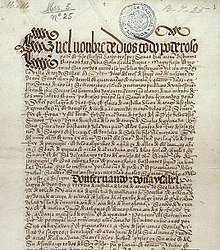
The House of Aviz has produced numerous prominent figures in both European and global history, including Prince Henrique the Navigator, King Manuel I of Portugal, and Holy Roman Empress Isabel of Portugal. Numerous Aviz dynasty have also claimed thrones or titles across Europe, including King Pedro V of Aragon
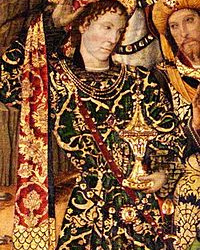
and João, Prince of Antioch.
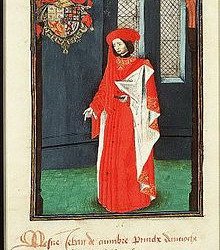
The Aviz ruled Portugal from 1385 until 1580.
The founder of the House of Aviz, King João I of Portugal, was born in 1357 as the illegitimate child of King Pedro I of Portugal, a member of the Portuguese House of Burgundy, and Teresa Lourenço, daughter of a Lisbon merchant. In 1364, at 7 years old, João was made Grand Master of the Order of Aviz,
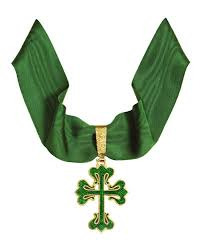
henceforth becoming known as João of Aviz.
The House of Aviz was established as a result of the dynastic crisis following the 1383 death of Fernando I. Fernando’s widow Leonor Telles was disliked by both the nobility and the commoners for having left her first husband and for having had their marriage annulled in order to marry King Fernando. Fernando’s designated heir was their only surviving child Beatriz,
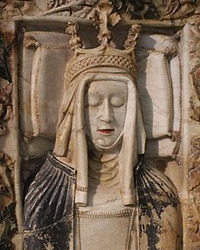
married to Juan I of Castile

who claimed the throne in the name of his wife, but under the Treaty of Salvaterra de Magos that had been the basis for Juan's marriage to Beatriz, the unpopular Leonor was left as Regent until such time as the son of Beatriz and Juan would be 14 years old.
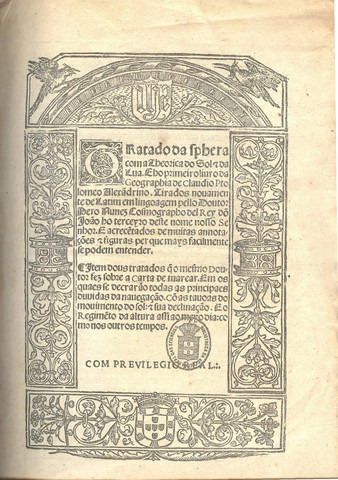
In April 1385, amidst popular revolt and civil war, the Cortes of Coimbra declared João, Master of Aviz, as king João I of Portugal. He was half-brother of Fernando and natural son of Fernando’s father and predecessor Pedro I. He had the particular backing of the rising bourgeoisie of Lisbon; the nobility were split, with the majority favoring the legitimist Beatriz. Troops under General Nuno Álvares Pereira

defeated a small Castilian army at Atoleiros,

while Juan of Castile had to lift a siege to Lisboa, mainly due to a plague that hit his army and killed his wife Beatriz. This was followed, however, by a larger invasion of Castilian and Portuguese troops loyal to Juan of Castile.
João of Aviz's rule became established fact with the Portuguese victory in the Battle of Aljubarrota on 14 August 1385, where he defeated Juan I of Castile.
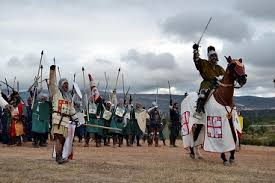
A formal peace between Portugal and Castile would not be signed until 1411.
To mark his victory, João founded the Monastery of Santa Maria da Vitória, known as the "Batalha Monastery",
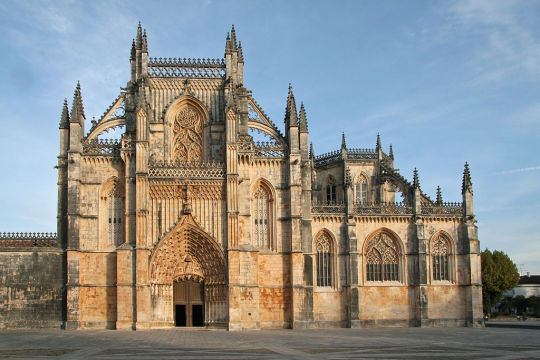
whose chapel became the burial place of the princes of the new dynasty of Aviz.

The descendants of King João I were still also Masters of Aviz, though at times that title passed to one descendant of João and the Crown of Portugal to another. The title of Grand Master of the Order of Aviz was permanently incorporated into the Portuguese Crown toward the end of rule by the House of Aviz, in 1551.
The House of Aviz would rule Portugal until its fall in the 1580 to the Philippine Dynasty.
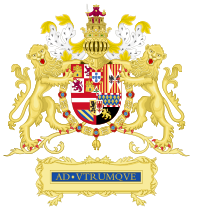
after he had ordered the Duke of Alba to take Portugal by force.
This period of Portuguese history saw the ascent of Portugal to the status of a European and world power. The conquest of Ceuta in 1415
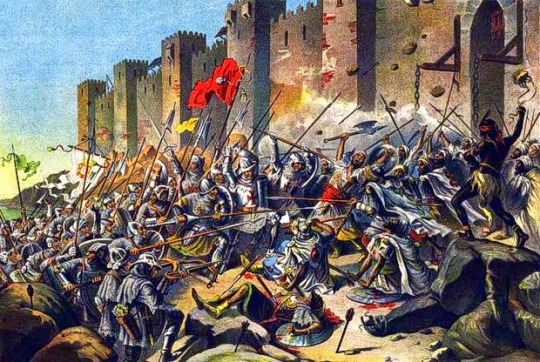
was its first venture in colonial expansion, followed by a great outpouring of national energy and capital investment in the exploration of Africa, Asia and Brazil with the founding of colonies to exploit their resources commercially. The period also includes the zenith of the Portuguese Empire during the reign of Manuel I and the beginning of its decline during João III's reign.
João III was succeeded in 1557 by his grandson Sebastião I of Portugal, who died, aged 24 and childless, in the Battle of Alcácer Quibir.
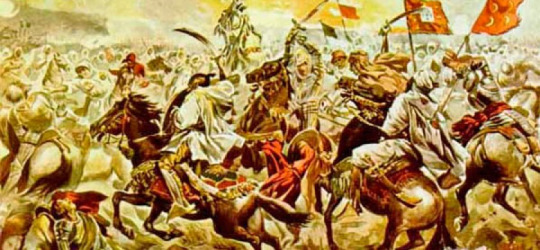
Sebastião was succeeded by his great-uncle Henrique, aged 66, who, as a Catholic Cardinal, also had no children. The Cardinal-King Henrique died two years later, and a succession crisis occurred when pretenders to the throne including Catarina, Duchess of Braganza,

Philip II of Spain,

and António, Prior of Crato claimed the right to inherit it.
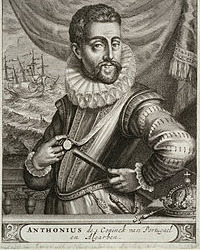
António, Prior of Crato, was acclaimed king in several cities around the country in 1580, twenty days before Philip II of Spain invaded Portugal and defeated the supporters of António in the Battle of Alcântara.

Although António had been proclaimed king, and was still regarded as rightful king in some of the Azores Islands until 1583, his legitimacy as a monarch is still disputed by historians. Only a small minority of historians (even in Portugal) accept the period of twenty days between Antonio's acclamation and the Battle of Alcântara as his reign. In Portugal he generally considered not as a national king, but as a patriot who led armed resistance to the Philippine domination.
Joaquim Veríssimo Serrão, writing in 1956 and counting António as a king, dates the end of the dynasty's rule of Portugal as occurring in 1581–1582. The Cortes of Tomar had acclaimed Philip II of Spain as Philip I of Portugal in 1581, subsequently António's forces were utterly defeated at sea by Álvaro de Bazán at the Battle of Ponta Delgada

off São Miguel Island in the Azores, on 26 July 1582. António then retreated to Terceira, where he supervised the raising of levies for defense, but in November he left Angra do Heroísmo en route to France to persuade the French to furnish more troops, 800 of which arrived in June 1583. Philip had dispatched Santa Cruz with an overwhelming force which left Lisbon on 23 June, and reaching sight of São Miguel some time after 7 July, finally reduced the Azores to subjection.
The Cortes in Tomar acknowledged Philip II of Spain as King Philip I of Portugal on 16 April 1581 after this Spanish military intervention. From 1581, the House of Aviz had ceased to rule any portion of continental Portugal; António, Prior of Crato held out in the Azores into 1582 as António I of Portugal; the last of his allies in the islands finally surrendered in 1583.
The House of Aviz was succeeded in Portugal by Philip's personal union of the Crowns of Portugal and Spain. In Portuguese history this is variously referred to as the Philippine Dynasty, the House of Habsburg, or the House of Austria. Portugal and Spain would share a common monarch until 1640, upon the proclamation of the Duke of Braganza as John IV of Portugal.
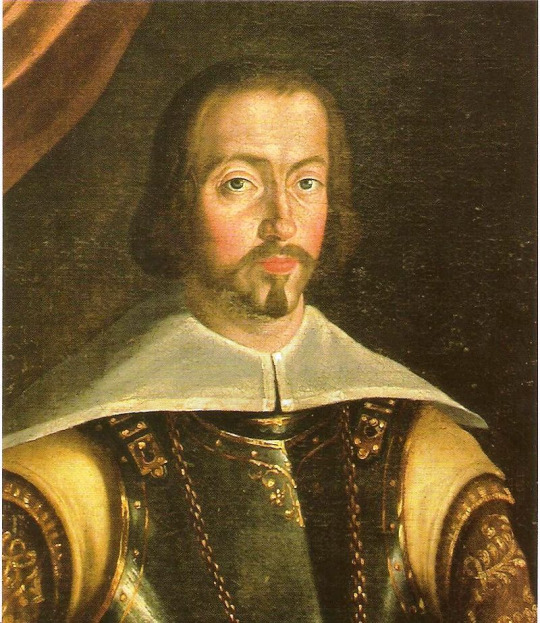
Aviz monarchs
João I of Portugal (1385–1433) Founder of the House of Aviz and the King with the longest reign of all the Kings of Portugal with 48 years.
Duarte I of Portugal (1433–1438) Oldest member of the Illustrious Generation
Afonso V of Portugal (1438–1481)
João II of Portugal (1481–1495)
Manuel I of Portugal (1495–1521) Formerly Duke of Beja
João III of Portugal (1521–1557)
Sebastião I of Portugal (1557–1578) Death at Battle of Alcácer Quibir triggers Portuguese succession crisis of 1580
Henrique I of Portugal (1578–1580) Last Aviz monarch recognized by the Portuguese Cortes
Symbols
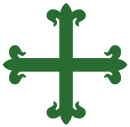
Following his success in succeeding to the throne following the 1383–1385 Portuguese interregnum, King João I of Portugal took the Cross of the Order of Aviz as his heraldic badge, adding it to the coat of arms of Portugal and the according royal flags. King João I enforced the imagery of his position as Grand-Master of the Order of Aviz, lending its name to his newly founded royal house and its cross as his personal charge on the royal arms. This was effected in various ways: by insertion within the bordure, alternating with the castles; more commonly inserted within the shield, and occasionally shown outside the shield with the latter laying over it. The Cross of Aviz is a cross flory vert (a green cross with a fleur-de-lys at the end of each arm).

The armillary sphere has been an important element of Portuguese heraldry since the reign of King Manuel I of Portugal. The armillary sphere became a royal badge for the Portuguese monarchy, apart from being part of the personal standard of King Manuel I. It acts as a supporter to the Coat of arms of Portugal, also present on the current Flag of Portugal.

Owing to the association with King Manuel I and other Aviz monarchs with the Portuguese discoveries, the armillary sphere was commonly used as a symbol representing Portuguese sovereignty across the Portuguese Empire. The symbol was a consistent motif in both Manueline and Neo-Manueline architecture.
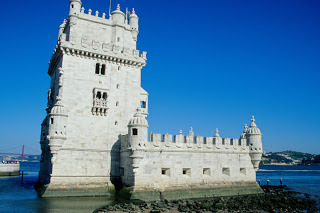
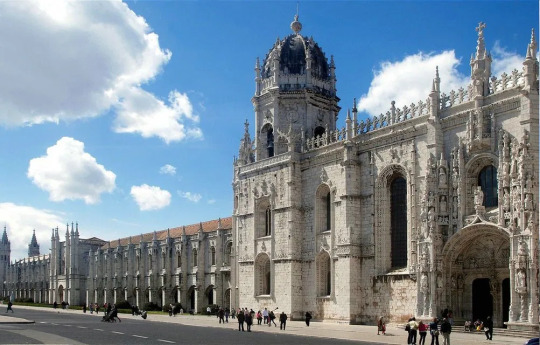
It also became particularly associated with Colonial Brazil and the subsequent United Kingdom of Portugal, Brazil, and the Algarves.
An important element of Portuguese heraldry since the 15th century, the armillary sphere was many times used in Portuguese naval and colonial flags, mainly in Brazil. It was a navigation instrument used to calculate distances and represents the importance of Portugal during the Age of Discovery,
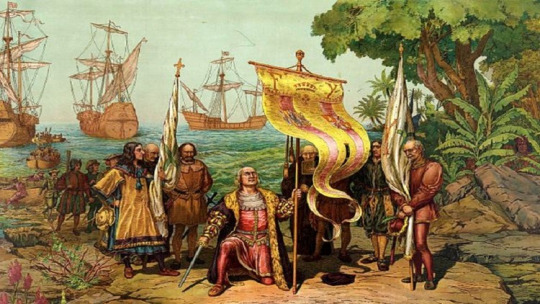
as well as the vastness of its colonial empire when the First Republic was implemented.
Coats of arms
King of Portugal - 1385–1580

King of the Algarves - 1385–1580

7 notes
·
View notes
Photo

Eugene Burkins (1876-1929?)
The Inventor of the “Burkins Automatic Machine Gun”
Eugene Burkins was born in St. Louis, Missouri (or Louisiana). Apart from learning how to read and write, Burkins had no formal education. He started out from humble beginnings. He was a shoe shiner in Chicago.
He had no prior experience making or using guns. He had never seen the field of battle or donned a military uniform. And yet, he was able to learn rather quickly how to develop an improved form of military hardware that would be considered the zenith of war technology to rival that of the most seasoned craftsmen in all the world.
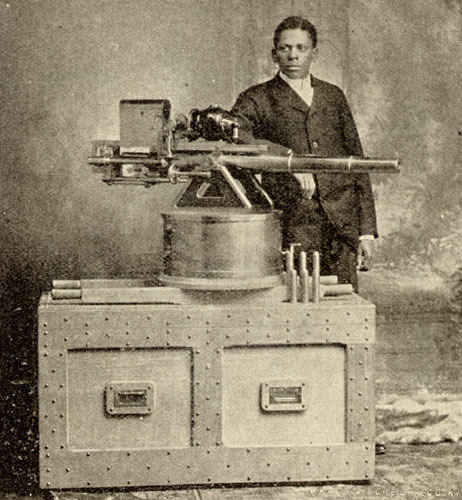
(Source: “Evidence of Progress Among the Colored People”, 1902)
So how did he do it?

In G. F. Richings’ book “Evidences of Progress Among Colored People” published in 1902, he explains:
He began first to make a careful study of the picture that appeared in the papers, showing the guns on the "Battleship Maine." Mr. Burkins saw in what way he could improve the machine-gun by increasing its rapid-firing capacity, and along that line he began to work His first model was mostly made with a pocket-knife.
Burkins shares his purpose for his invention in his application:
My invention relates to breech-loading cannon; and my object is to provide a construction particularly adapted to handling heavy ammunition so as to attain a much greater rapidity of fire than heretofore in guns of a caliber larger than are employed in the ordinary machine-guns, the same being more fully described hereinafter and illustrated in the accompanying drawings...

Figure 1 is a side elevation of the breech portion of a cannon, upon which is mounted the mechanism in which my invention is embodied, the front portion of the cannon being shown broken away, and also a large portion of the right side of the case of the ammunition-magazine is shown broken away to illustrate a vertically-arranged series of rubber covered rollers mounted to revolve on bearings at each end within the magazine-casing and adapted to convey the ammunition downwardly, as is particularly described hereinafter.

Fig. 2 is a plan of the parts shown in Fig. 1.

Figs. 3 and 4 are-respectively front and rear elevations to illustrate the mechanism for operating and supporting the breech block.


Fig. 5 is an axial vertical section of the breech portion of the barrel of a cannon and of two rings mounted thereon for supporting the breech-loading mechanism. The breech-block is also shown in axial vertical section; but the cartridge-carrier has one side broken away to illustrate position of superimposed breech-block when the gun is in the closed'position. The cartridge-magazine is shown in section on a vertical plane coincident with the axial centers of the cartridges shown therein in elevation.
Fig. 6 [not shown here] is a vertical axial section similar to what is shown in Fig. 5, except that in Fig. 6 the breech is at the extreme open position just after having extracted and thrown out the discharged cartridg'eshell, which is shown in a falling position in broken lines...
You can read the rest of the specifications here.

Illustration of launching of USS Maine at Brooklyn Navy Yard, New York. Printed in Harper's Review in 1890 (Source: New York Times via Wikipedia)
Construction on the USS Maine started on October 17, 1888. It was one of the very first U.S. naval battleships. The ship was launched on November 18, 1889.
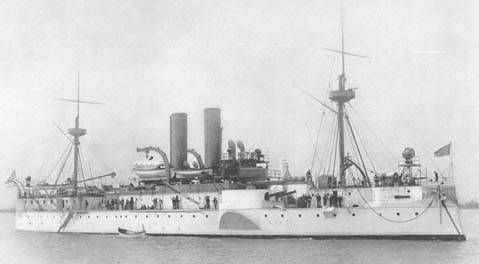
The U.S.S. Maine, 1897, Detroit Publishing Company (Source: Library of Congress)

Panoramic photograph taken on the 13th anniversary of the destruction of the U.S.S. Maine, Havana Harbor, February 15, 1911 (Source: Library of Congress)
Its saga on the seas would come to an end on February 15, 1898, when a fire on board the ship triggered an explosion, killing 266 out of 354 total American crew members while docked in Havana, Cuba.

"Maine" wreck, Havana Harbor, W. to Custom House (with tower, on right), Cuba, photo by Underwood & Underwood, c1903 (Source: Library of Congress)
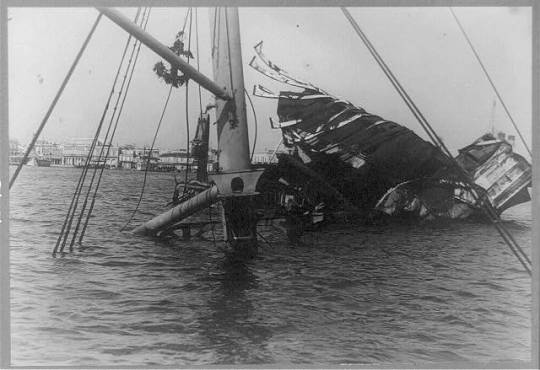
Wreck of the Maine, Havana Harbor, Cuba, March 1899 (Source: Library of Congress)
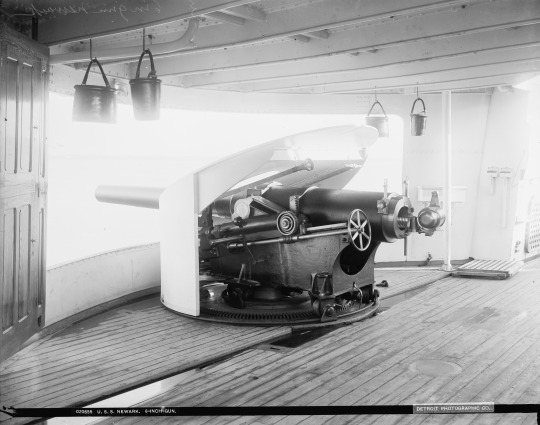
Six-inch gun on the U.S.S. Newark. The USS Maine mounted six of these. Photo by Edward H. Hart, Detroit Publishing Company, between 1891 and 1901 (Source: Library of Congress)

Teaching Columia Men on the Wasp to Shoot, August 20, 1916
Students unable to leave on the Maine (BB-10) for the training cruise will be put on the battleship at sea from the converted yacht Wasp, aboard which they are learning to handle the 3-inch pieces.
(Source: New-York Tribune, Library of Congress via NavSource Naval History)

Gun Practice - 5" gun crew of the Maine (BB-10), circa 1917-18, Photo by Navy Dept., Bureau of Construction & Repair (Source: U.S. National Archives via NavSource Naval History)
Burkins filed his application with the patent office on June 10, 1899. It is likely that what he saw was a preview of the plans for the ship being advertised in a newspaper article. If it was the original U.S.S. Maine that inspired his journey of innovation, then it is safe to assume that it took him 10 years to develop the Burkins gun.

“The Old and The New Battleship Maine” Virginian-Pilot, February 17, 1899 (Source: Library of Virginia via NavSource Naval History)

The Saint Paul Globe, February 5, 1899 (Sources: Minnesota Historical Society, Library of Congress via NavSource Naval History)

“The New Battleship Maine” From an illustration in Leslie's Weekly, December 1, 1898 (Source: The National Tribune, Library of Congress via NavSource Naval History)
This description appeared in the Virginian-Pilot on February 17, 1899:
The new battleship Maine, the keel of which has just been laid, is to have a speed of l8 knots. She will be a ship of 15,500 tons displacement and in her main battery will carry four 12 inch guns and twelve 6 inch guns. These figures give a partial idea of the superiority of the new Maine over the old one. Among other things the new Maine will probably have underwater torpedo tubes, the first ever put in any ship in the American navy.
All the guns of the Maine, except the big 12 inch ones in the turrets, will be of the rapid fire pattern. Her secondary battery will be exceptionally strong. She will be 368 feet on the water line, 27 feet beam and will have a draft of 24 feet 7 inches when she has full supplies of stores and ammunition and 2,000 tons of coal on board. The wonderful Krupperized armor has proven so good that the Maine will have 12 inch plates of it put on her instead of the 16.5 inch Harveyized armor originally planned for.
This new battleship came with its own set of problems - not meeting speed expectations, an undisciplined crew,

The battleship Maine (BB-10) strikes the water for the first time, July 28, 1901 (Source: New-York Tribune, Library of Congress via NavSource Naval History)

“President Reviews Mighty Fleet; Low Clouds and Fog Mar Beauty of Spectacle” The Washington Times, September 3, 1906 (Source: Library of Congress via NavSource Naval History)
Battleships and navy guns were a big deal at this time. One of the justifications for the Spanish-American War was that the United States needed to strengthen its presence in the Caribbean against the threat of other world powers such as their long-standing rival Great Britain. In addition, the United States felt they had economic interests to secure in Cuba. Some former United States citizens had fled to Cuba after the Confederate rebellion was crushed during the American Civil War. (Some of these people brought their slaves with them.)
After the United States decided to assist the people of Cuba in their fight against the Spanish government in their country, the U.S. sought to control the island’s foreign policy, exploiting an advantage in extending their own political power in the world.
Soon, there were fears that the western United States was open to a possible attack from Spain. Therefore, the United States sought to claim the Philippines as well, but first, they would have to fight both the Spanish and later, the militant Filipino population known as the Moros between 1899 and 1902.
Amidst all of these factors, the United States Navy had been preparing for the worst.

The following is an excerpt from Indiana Senator Albert J. Beveridge’s speech “March of the Flag,” which he delivered during an Indiana Republican Meeting Indianapolis, Indiana on September 16, 1898:
“Hawaii is ours; Porto Rico is to be ours; at the prayer of her people Cuba finally will be ours; in the islands of the East, even to the gates of Asia, coaling stations are to be ours at the very least; the flag of a liberal government is to float over the Philippines, and may it be the banner that Taylor unfurled in Texas and Fremont carried to the coast.
The Opposition tells us that we ought not to govern a people without their consent. I answer, The rule of liberty that all just government derives its authority from the consent of the governed, applies only to those who are capable of self government. We govern the Indians without their consent, we govern our territories without their consent, we govern our children without their consent. How do they know what our government would be without their consent?”...
The ocean does not separate us from lands of our duty and desire - the oceans join us, rivers never to be dredged, canals never to be re paired. Steam joins us; electricity joins us-the very elements are in league with our destiny. Cuba not contiguous? Porto Rico not contiguous! Hawaii and the Philippines no contiguous! The oceans make them contiguous. And our navy will make them contiguous.

1914 portrait of Albert Beveridge (1862-1927) (Source: Library of Congress)
He continues:
...So Hawaii furnishes us a naval base in the heart of the Pacific; the Ladrones another, a voyage further on; Manila another, at the gates of Asia - Asia, Asia, to the trade of whose hundreds of millions American merchants, American manufacturers, American farmers, have as good a right as those of Germany or France or Russia or England; Asia, whose commerce with England alone, amounts to billions of dollars every year; Asia, to whom Germany looks to take the surplus of her factories and foundries and mills; Asia, whose doors shall not be shut against American trade. Within two decades the bulk of Oriental commerce will be ours, - the richest commerce in the world. In the light of that golden future, our chain of new-won stations rise like ocean sentinels from the night of waters, - Porto Rico, a nobler Gibraltar; the Isthmian canal, a greater Suez; Hawaii, the Ladrones, the Philippines, commanding the Pacific!
Ah! as our commerce spreads, the flag of liberty will circle the globe, and the highways of the ocean - carrying trade of all mankind, be guarded by the guns of the republic. And, as their thunders salute the flag, benighted peoples will know that the voice of Liberty is speaking, at last, for them; that civilization is dawning, at last, for them - Liberty and Civilization, those children of Christ's gospel, who follow and never precede, the preparing march of commerce! It is the tide of God is great purposes made manifest in the instincts of our race, whose present phase is our personal profit, but whose far-off end is the redemption of the world and the Christianization of mankind. And he who throws himself before that current is like him who, with puny arm, tries to turn the gulf stream from its course, or stay, by idle incantations, the blessed processes of the sun...
Fellow Americans, we are God is chosen people... His power directed Dewey in the East and delivered the Spanish fleet into our hands on the eve of Libertyís natal day, as he delivered the elder Armada into the hands of our English sires two centuries ago.
For President Theodore Roosevelt, who was himself a committed imperialist,a display of America’s military might was not complete without both battleships and the boom of the big cannons.
It is therefore not unreasonable to assume that Burkin’s weapon, given the circumstances, would likely have been used as a weapon of war to further the objectives of U.S. Imperialism.

An Imposing Spectacle: Birds-eye View Showing Position of Fleet in Naval Review at Oyster Bay, September 4, 1906 (Source: Salt Lake Herald, University of Utah, Marriott Library via NavSource Naval History)
On September 3, 1906, as the new battleship Maine along with 93 other battleships, destroyers, and cruisers in three long columns sailed past the president and a crowd of thousands gathered off the coast of Long Island, they all gave a twenty-one-gun salute. The 46 powerful “Big Fighters” numbered 1, 178 six, eight, or thirteen-inch guns.

Circa 1907 photograph of US Navy battleships of the Maine, Virginia & Connecticut -classes & other units of the Atlantic fleet at a Naval Review off Old Point Comfort, Photo by William H. Rau, Philadelphia, Pennsylvania (Source: Library of Congress, National Museum of the U.S. Navy via NavSource Naval History)
The press called it “the finest fleet that the United States has ever assembled” and “America’s Greatest Marine Pageant”.
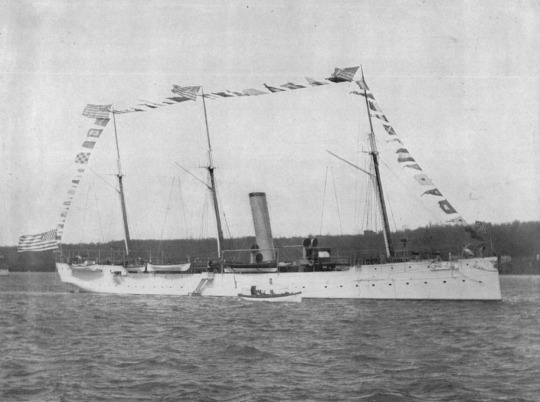
U.S.S. Dolphin from Photographic History of the Spanish-American War, page 192 (Source: Library of Congress)
First Lady Eleanor Roosevelt was on board the Dolphin nearby with other guests. Prior to the blasts of gunfire, a band played the Star-Spangled Banner and a flag was raised to the top of the pole on the naval yacht Mayflower, where the president was having lunch with government officials and military officers.
“By George, that is good,” the president could be heard shouting above the noise, followed by his infectious laughter.

Watching from the deck, Roosevelt proudly declared
“Any man who fails to be inspired by such a sight as this is a mighty poor American. Every American who sees it ought to be a better American.”

“The Great Naval Review At Oyster Bay: The Flagship Maine Saluting”, September 3 & 4, 1906 (Source: New-York Tribune, Library of Congress via NavSource Naval History)

“Party On The Mayflower”
You can see a diagram showing the inner workings of a battleship gun here.
The Spanish-American War of 1898 ended with the Treaty of Paris, which secured Guam, the Philippines, and Puerto Rico as territories of the United States.
You can just imagine from these pictures the creativity of this brother Burkins who truly believed that he could tackle a project of such magnitude during such a time of widespread controversy and then set out to work.

Portrait of Henry Baker from his book “The Colored Inventor: a Record of Fifty Years” published by the Crisis Publishing Company in 1913 (Source: Schomburg Center for Research in Black Culture/New York Public Library)
Henry Edwin Baker, Jr. (1857-1928) was the third African American to enter the United States Naval Academy in 1875. He was appointed "copyist" in the United States Patent Office starting in 1877 and was later promoted to serve as an assistant patent examiner.
It was in this position that he would chronicle the history of African-American inventors.
In a 1902 essay titled “The Negro As An Inventor” for Daniel Wallace Culp’s “Twentieth Century Negro Literature; Or, A Cyclopedia of Thought on the Vital Topics Relating to the American Negro,” he wrote the following:
The official records of the United States Patent Office, with a single exception, give no hint whatever that of the thousands of mechanical inventions for which patents are granted annually by the government, any patent has ever been granted to a Negro. The single exception was the name of Henry Blair of Maryland, to whom the public records refer as "a colored man," stating that he was granted a patent for a corn harvester in 1834 and another patent for a similar invention in 1836.
It is altogether safe to assume that this Henry Blair was a "free person of color," as the language of those days would have phrased it; for the government seemed committed to the theory that "a slave could not take out a patent for his invention." And this dictum gave rise to some rather embarrassing situations on more occasions than one. For instance, in 1857, a Negro slave, living with his master in the state of Mississippi, perfected a valuable invention which his master sought to have protected by a patent. Now, in law, a patent is a contract between the government and the inventor or his assignees. The slave, although the inventor, could not under the law be a party to a contract, and therefore could not secure the patent himself. His master applied for the patent, but was refused on the ground that inasmuch as he was not the inventor and could not be the assignee of a slave, he could not properly make the required oath. The master was not satisfied with this interpretation of the law by the Commissioner of Patents, and at once appealed from the latter's decision to the Secretary of the Interior, who, in 1858, referred the case to the Attorney-General of the United States. This latter official, who was Hon. Jeremiah S. Black, of Pennsylvania, confirmed the decision of the Commissioner of Patent, and neither master nor slave was ever able to get a patent for the slave's invention. This case reported on page 171 of volume 9, of "Opinions of Attorneys-General, United States."
Another instance of a similar character occurred a few years later, in 1862, when a slave belonging to Jefferson Davis, President of the Confederacy, invented a propeller for vessels. He constructed an excellent model of his invention, displaying remarkable mechanical skill in wood and metal working. He was not able to get his invention patented, but the merits of his invention were commented upon approvingly by a number of influential Southern newspapers, and his propeller was finally put in use by the Confederate navy.
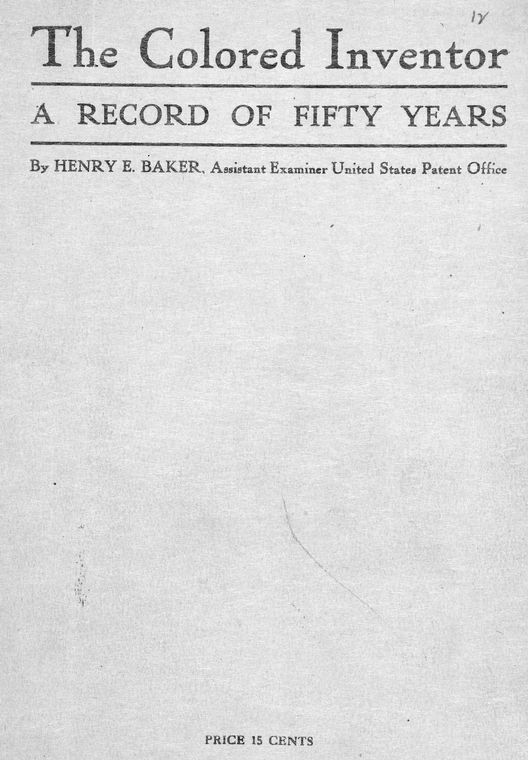
He continues with the story of Eugene Burkins.
Another invention by a young colored man which has attracted considerable attention is the rapid-fire gun by Mr. Eugene Burkins, of Chicago. This gun has been examined by officers of the War and Navy Departments, and has been pronounced a valuable contribution to the scientific equipments for military and naval warfare.
The following description of Mr. Burkins' gun appeared in Howard's American Magazine some months ago:
"A brief description of the gun is not exactly out of place, although the Scientific American and other technical journals have long since given it to the world. It is an improvement upon all that has yet been done in the way of ordnance, and the principles involved in its construction can be applied to any size of gun, from a one-inch barker to a thirty-six-inch thunderer. The model as it now stands weighs 475 pounds, measures four inches at breech, and is constructed of the finest of gun brass at a cost of $3,500. There is a magazine at the breech in which a large number of heavy shells can be held in reserve, and in the action of the gun these slip down to their places and are fired at the rate of fourteen a minute, an improvement on the Maxim gun of four shots. The gun is elevated upon a revolving turret with electrical connections, enabling the gunner to direct the action of the machine with a touch of his finger. Firing, reloading and ejection of shells are all effected by electricity, and a child could conduct the work of manning the gun as easily as anyone."

Portrait of Admiral Dewey in The San Francisco Call, September 14, 1903 (Source: University of California, Riverside via NavSource Naval History)
Admiral George Dewey (1837-1917) is quoted in Baker’s biographical account as saying that it was
"by far the best machine-gun ever made."
G. F. Richings continues with more details:
It shoots seven times more a minute than the Gatling gun, and will doubtless take the place of other machine-guns. Several foreign countries have offered large sums for the right to manufacture it for their navies; but Mr. Burkins and Mr. Madden, his partner, proposed to control the manufacturing interest in this country.
According to the U.S. Census Bureau, a Eugene Burkins was born in 1877 who would have been 33 in 1910. There is an entry in the 1900 census that identifies a Eugene Burkins living in Cook County, Illinois. A death certificate exists for a Eugene Burkins who died in 1929.
However, there is even more information available which is directly linked to Burkin’s name and success...

The following article appears in The Inter Ocean [Chicago, Illinois] dated Sunday, April 8, 1900:
NEGRO LAD INVENTS NEW GUN Eugene Burkin of Chicago Constructs a Rapid-Fire Machine Weapon Eugene Burkin, a colored boy of l9 years, who lives over on Chicago's great [West] Side, is the inventor of a rapid-fire machine gun which he claims is the most effective weapon of its kind in the world, and is destined to throw the inventions [of] Maxim and Nordenfeldt, now in general use in the armaments of the world, into the scrap heap. Several experts who have seen the model of Burkin's gun pronounce it a marvel of ingenuity and a terrible weapon. The boy is said to have refused an offer of $50,000 for his invention through motives or patriotism, he being desirous that the United States government should have the first opportunity to test and purchase the weapon. Burkin is a source of pride to the colored population of Chicago, who are jubilant that one or their race should develop the creative power. The boy has never had any mechanical training, yet all the work on his model has been his own. The first idea of the weapon came to him during the Spanish-American war, when the magnificent work of the American gunners directed his thoughts to guns and their improvement. He constructed his first model of wood, his only tool being a jackknife. The lack of funds then threatened to put a stop to the young inventor's work, but he finally obtained enough money to go into an ironworks on the West Side, which gave him the use or its tools and machinery for $5 a day. Here he constructed the model, which he sent to the patent [office] at Washington, which has already allowed seventeen of his claims on the weapon. Prominent men of the colored race are using their influence to induce the War Department at Washington to conduct a series of tests with the gun. It has been christened the "Maine."
Rapid-fire guns had been around for a long time. There was clearly a sort of arms race going on.
While the Burkins gun had evidently exceeded the rate of fire for other guns of its time, the manufacturers of these other guns rolled out modified designs with multiple barrels, increasing the potential firepower 10-fold and beyond.
This might be one of the reasons that the Burkins gun did not see as much action on the field of battle. It is difficult to find much information on its usage or any surviving models.
Here is what the other guns named in comparison to the Burkins gun looked like:
Nordenfeldt Machine Gun by the Nordenfelt Company
Inventor: Swedish engineer Heldge Palmcrantz
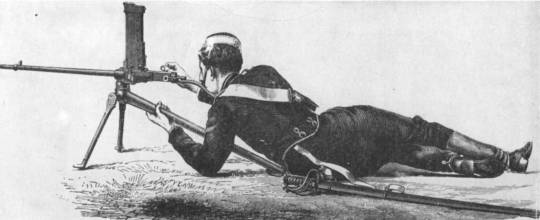
Nordenfelt Single-Barrel Machine Gun (Source: ibiblio)
This gun weighed only 13 pounds, and could be fired by the average soldier at a rate of 180 shots a minute.
Here is a handbook.

Sailor operating 10-barrel Nordenfelt rifle-calibre machine gun, with right hand on lever, circa 1880s-1890s (Source: Contemporary Ordnance manual found on Steve Johnson's CyberHeritage website via Wikipedia)
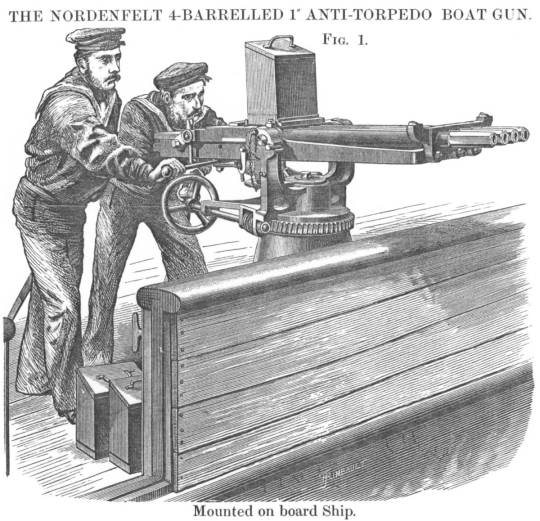
Woodcut depicting Royal Navygunners in action with Nordenfelt 1-inch 4-barrel anti-torpedo boat gun on shipboard mounting. The gun captain, left, is operating the training handwheel, c. 1890s (Source: Contemporary Ordnance manual found on Steve Johnson's CyberHeritage website via Wikipedia)

Nordenfelt Machine Gun, Cal. .45, Five-Barrel Model. Mounted in Top of a Fighting Ship to Sweep the Decks of the Enemy (Source: ibiblio)

Nordenfelt Machine Gun, Cal. .45, with Gun Carriage Convertible to Tripod Mount (Source: ibiblio)
This model had a rated speed of 1,200 shots per minute with shorter bursts.
Maxim Machine Gun by the Maxim Gun Company
Inventor: American-born British inventor Hiram Maxim (1840-1916)

When Maxim built his first working model in 1884, he found it could fire 666 rounds of ammunition in under a minute.
In one demonstration, Hiram Maxim chopped down a tree with one of his guns.
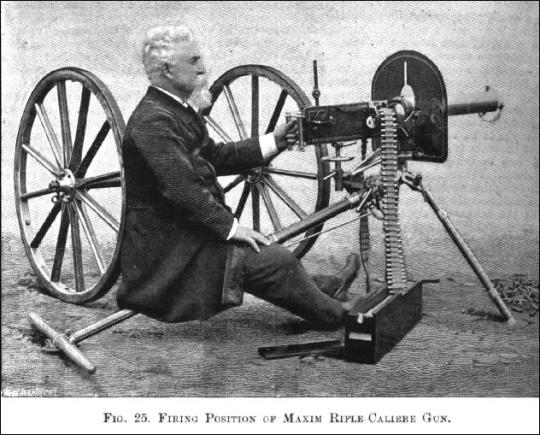
Hiram Maxim sits with the first portable, fully automatic machine gun, which he invented, and a Dundonald gun carriage, pre-1914 (Source: Imperial War Museums)

CPO demonstrating a Maxim-Nordenfeldt 1-pdr Mark 6 aboard USS Hist about 1898 (Source: U.S. Naval Historical Center via NavWeaps)
Gatling Machine Gun by the Miles Greenwood & Company, McWhinny, Rindge & Company, Cooper Fire Arms Manufacturing Company, and finally the Gatling Gun Company under Colt's Patent Fire Arms Company
Inventor: American inventor Richard Gatling (1818-1903)

A Section View Showing the Action of Gatling's First Model Gun (Source: ibiblio)

Gatling Gun, Model 1883, Ten-Barrel, Cal. .45, with Accles Feed Drum (Source: ibilbio)

An experimental 1877 Gatling Gun on a tripod with Lucien F. Bruce's 1881 patent feed system (Source: Connecticut State Library)

Dr Richard Gatling, with a Colt ‘Bulldog’ Gatling Model 1893 (Source: Connecticut State Library via Flickr)
Gatling put issued a public challenge for anyone to prove their gun’s superiority to his. It appeared in an English publication in September 1881 and read as follows:
Recently many articles have appeared in the press claiming superior advantages for . . . other machine guns over the Gatling system. In order to test the question which is the better gun, the undersigned offers to fire his gun (the Gatling) against any other gun on the following wagers, viz:
First--£100 that the Gatling can fire more shots in a given time, say one minute, than any other gun in the world.
Second--£100 that the Gatling can give more hits on a target, firing, say one minute, at a range of 800 or 1000 yards, than any other gun.
The winning party to contribute the wagers won to charitable objects.
The time and place for the trials to be mutually agreed upon. Trials of the above character will do more to determine the efficiency of the guns than newspaper articles ever so cleverly written.
(Signed) R. J. Gatling Of Hartford, Conn., U.S.A.

U.S. Navy soldiers useing the Gatling gun in the ‘fighting top’ of a man-of war ship (Source: Small Arms Defense Journal)

Gatlings at Baiquiri, Cuba Just before starting for the front in the Spanish-American War (Source: ibiblio)

War Department Letter Attesting Capabilities of Gatling Mechanism (Source: ibiblio)
Henry Baker stated that slavery had been a barrier for African-American inventors. Chances are that if Burkins had been born during his parents’ generation, he would not have received the credit he was due for his hard work and it would have likely ended up being used for the purposes of the U.S. government or a government fighting against the United States while someone else got credit or no one at all. Either way, it would have been an unsatisfactory outcome for Burkins. Surely, his invention would not have carried on his name as we are aware of it today.
At the end of the 19th Century, the United States Patent Office sought to document information regarding patents submitted by “colored inventors.” They received from the public 400 claims of such patents that were granted and about another 400 more cases in which the person attempted to submit a patent upon completion of their invention but abandoned the application process altogether for one reason or another.
Summarizing 2 attempts by the patent office as of 1913, Baker wrote:
“...something over 1,200 instances have been gathered as representing patents granted to colored inventors, but so far only about 800 of these have been verified as definitely belonging to that class.”
Most often, African-American inventors did not have the means to hire a patent lawyer and submit a patent application.
Even Burkins could not have done it alone. He had to wait a full year after he submitted his patent application to receive approval. First, he needed help funding the construction of the gun and later on, he would need assistance with the manufacturing process once it was ready.
He received financial support from a number of prominent black citizens. One of the major backers of this effort was Major John C. Buckner, an Illinois Internal Revenue Collector and strong advocate of black empowerment.
Another wealthy man in Chicago, Martin B. Madden, furnished over $3,000 towards the perfection of Burkin’s model. Burkins became an entrepreneur when they started the Burkins-Madden Gun Company together in Chicago.
The company, which specialized in “manufacturing and dealing in firearms and ammunition”, was incorporated with a capital of $50,000.
Five years later, Burkins patented a new and improved Bottle Seal involving the use of cement, a cork, and a stopper.

This invention has relation to non-refillable bottles, and has for its object the provision of novel means whereby if the bottle be opened after having been originally filled the integrity of the bottle as an original package will be destroyed, thus preventing its fraudulent reuse and indicating to the purchaser that the bottle has been refilled.
In carrying out my invention I provide a bottle and a cap of glass, metal, composition, or other suitable material not too hard to break adapted to be fitted over the top of and securely fastened to the neck of the bottle and of such form and construction that in order to remove the cork from the bottle the cap must be broken off, a portion thereof remaining immovably fixed on the neck of the bottle and serving to show at a glance that the bottle has been opened after having been once filled...
The collar E of the cap screws down upon the threaded exterior of the neck A of the bottle and is intended to remain in fixed position thereupon, and in order to retain it in position a layer of cement G is inter posed between the thread on the neck and the thread on the inside of the collar, so that when the cap is screwed down upon the neck and the cement is allowed to dry it will be impossible to unscrew the cap from the bottle...
After the upper part of the cap has been broken 05 the collar'E and a portion of the legs F will remain upon the neck of the bottle and will indicate that the bottle has been opened and prevent the bottle from being used again as an original package, the integrity of the same as a whole, considering the cap as an essential portion of the bottle, having been destroyed by breaking off the cap.
His final patent was the new and improved Milk Dipper in 1906.

which when opened will allow the milk to discharge from the bottom of the dipping-cup and which will automatically close when released, thereby shutting oil. the discharge of milk from the cup.
By this time, Burkins and his mother Francis had moved to St. Louis, Missouri.
In 1910, Burkins was self-employed as chauffeur and he owned a restaurant.
Henry Baker used Burkin’s story last in his essay on black inventors. He concluded his work with the following statement...
These inventions show how completely in error are those who constantly assert that the Negro has made no lasting contribution to the civilization of the age, and they prove conclusively that under favorable environment he is capable of performing his whole duty in the work of mankind whether it be tilling the earth with his hoe or advancing the world by his thought.
We may never know for sure if Eugene Burkins was an Imperialist at heart or one who took the side of the Anti-Imperialist League against the use of weapons like that of his own making towards destructive uses in foreign lands.
We don’t know if Mr. Burkins was okay with depriving other people of their personal rights to self-determination in favor of U.S. nationalism and western civilization.
What we do know is that a black man in the United States of America got to work and when he was done, he chose to honor his national heritage.
Did he ever make his nation proud?
Did he ever have any regrets about his work?
What we do know is that the one they wanted to fail was successful...and regardless of what they thought about him, his aim was high and he gave it his best shot.
Credit:
Nasir Muhammad of Black Mecca of the South Tours
https://www.facebook.com/photo.php?fbid=10212105345086331&set=a.1195255318978.2030464.1156290208&type=3&theater
https://www.facebook.com/220368201489554/photos/a.220372264822481.1073741828.220368201489554/609517145907989/?type=3&theater
J. D. Thomas of Words From Us
https://www.facebook.com/photo.php?fbid=10217146943532868&set=p.10217146943532868&type=3&theater&ifg=1
Michael Mohl of NavSource Naval History
http://www.navsource.org/archives/01/10a.htm
http://www.navsource.org/archives/01/00a.htm
Larry Jewell and Patrick Clancey of the HyperWar Foundation
https://www.ibiblio.org/hyperwar/USN/ref/MG/I/MG-2.html
#blackhistory#blackness#black#black gun ownership#second ammendment#Eugene Burkins#Burkins machine gun#machine gun#gun control#imperialism#Spanish American War#USS Maine#Cuba#African American#research#patents#US Army#US Navy#US Military#Gatling gun#Maxim gun#black inventors#milk dipper#bottle seal#firearms#manufacturing#Confederacy#Confederate States of America#Jefferson Davis#Theodore Roosevelt
4 notes
·
View notes
Text
Ladies of Legend: Morgan le Fay and Morgause
References: Women of Camelot: queens and enchantresses at the court of King Arthur (Orchard Australia, 2000) by Mary Hoffman, Le Morte d’Arthur in two volumes: volume one and volume two (J.M. Dent & Sons Ltd, 1978, originally published in 1485) by Sir Thomas Malory, Mythology: Myths, Legends, & Fantasies (Hodder, 2013) by Dr. Alice Mills, The Complete Book of Witches and Wizards (Carlton Books Ltd, 2007) by Tim Dedopulos
Trigger warning: references to rape
There is a tendency, in Arthurian legend, for Igraine’s daughters to be highly variable in number and almost entirely interchangeable in identity, their roles within different versions of the myth generally depending on which woman gives birth to which sons. The Vulgate Cycle, for instance, has a whole crowd of half-sisters, while other versions whittle it down to one or two. The Complete Book of Witches and Wizards credits Morgan le Fay with eight sorceress sisters – Cliton, Gliten, Glitonea, Mazoe, Modron, Moronoe, Thitis and Tyronoe – all living together on the island of Avalon and acting as good fairies at Arthur’s birth. Mythology: Myths, Legends and Fantasies speculates that Morgan le Fay may have originally been a Celtic sea goddess or even a goddess of death. She has associations with the Morrigana, an Irish triple goddess represented by the three warrior queen aspects of Badb, Macha and Morrigan, the latter of whom is also strongly associated with fertility.
In Le Morte d’Arthur, there are three sisters: Morgause (alternatively spelled Margawse) being the eldest, Elaine the middle child and Morgan as the youngest. They were the children of Duke Gorlois of Cornwall and Igraine. When Gorlois was defeated in battle by King Uther Pendragon, Igraine had little choice but the marry the victor. She gave birth to a son, Arthur, who was taken away to be raised with a foster family, his very existence a well-kept secret. Uther then used his newly acquired stepdaughters to secure political alliances, marrying Morgause off to King Lot of Orkney and Elaine to King Nentres of Garlot. At this point Elaine promptly vanishes from the narrative.
Morgan was perhaps too young for marriage at the time because she was sent to a convent for an unexpectedly arcane education, learning the arts of necromancy and sorcery. Other stories have her trained at court by Merlin himself. Eventually, however, she was given a royal marriage of her own and became queen to Uriens of Gore.
Morgause had four sons with Lot – Gawain, Agravaine, Gaheris and Gareth. The only one to inherit any magical tendencies was Gawain, whose strength increased as the sun approached its zenith. When Arthur emerged from obscurity and Uther’s former allies went to war against him, including Lot, Morgause calmly came as a messenger to the embattled young king (with all of her boys in tow, what’s more) and had a month-long fling with him that resulted in a fifth son, Mordred. The relationship appears to have been consensual and mutually misinformed.
When Merlin finally told Arthur the truth, it came with a side serve of apocalyptic prophecy and the two of them threw a full King Herod routine by having all the baby boys born on May Day sent to sea to be drowned. Mordred survived. What’s more, he appears to have been raised by Morgause, because he shows up later in the story as a knight in Arthur’s court, not quite popular but respected and running around with the other Orkney boys. How he got from one point to the other is one hell of a mystery that Malory never explains.
Nentres and Uriens were also aligned against Arthur, though that did not stop Igraine bringing Morgan along when she met Arthur for the first time. Which means that Morgan was present, listening, when Igraine told the court how Uther appropriated her husband’s face in order to rape her.
The fight for the throne was brutal. During the final battle, thirteen kings were killed; among them, Morgause’s husband Lot, brought down by Arthur’s ally Pellinore. This was the beginning of a labyrinthine tangle of messed-up relationships, as Gawain eventually killed Pellinore and the widowed Morgause later took Pellinore’s son Lamorak as her lover.
Arthur held a great funeral, attended by Morgause and her sons, Morgan and her husband Uriens, and their son Ewaine (also spelled Yvain). Eager to connect with his half-sisters on a non-sexual level that is also not a battlefield – this family is such a disaster in so many ways – Arthur entrusted his sword Excalibur into Morgan’s care. Apparently she had a trustworthy vibe or something. Arthur proved once again that he was a shocking judge of people because not only did Morgan plan to use that sword for a double regicide, she had learned enough about Arthur’s personality to arrange it that he took every step into the trap for himself.
Arthur went hunting with Uriens and a knight called Sir Accolon who, unbeknown to the others, was Morgan’s lover and accomplice. The kings and their companion spied a beautiful ship floating in nearby waters and were invited to stay the night aboard by the twelve beautiful women who were its only occupants. However, when Uriens awoke he was in bed with Morgan – and when Arthur awoke, he was in the dungeon of Sir Damas, a knight in the middle of a property dispute with his little brother and who had a habit of kidnapping promising fighters in the hope that one of them would consent to be his champion. Thus far, nobody had. Arthur grimly offered himself on the condition that the other prisoners would be released. He didn’t realise that the messenger girl he was talking to was a servant of Morgan le Fay, or that the sword he went to fight with was not Excalibur at all. Morgan sent Accolon to Sir Ontzlake, Damas’ brother, to volunteer as his champion in the upcoming fight, and he had the true sword.
It’s neatly done. It would have worked beautifully had the Lady Nimue not been among the spectators, because in Le Morte d’Arthur it is she who received the training from Merlin, not Morgan, and after she got rid of him for good, she took over the role of Arthur’s intermittent protector. She forced Accolon to drop Excalibur, so that Arthur could reclaim it. Accolon confessed to everything. Morgan’s plan was to kill Uriens as well, take Accolon as her consort and rule the land herself. I shouldn’t like that. But I sort of do.
Expecting Accolon to have already succeeded, Morgan had moved in for the next kill. She sent a handmaiden for Uriens’ sword so that she could kill her husband with his own weapon – nasty sense of irony that the lady’s got there – but the handmaiden had qualms and woke Uwaine, who was sadly prepared for exactly this kind of situation. “I may say an earthly devil bore me,” he said, catching the sword before his mother could strike. She might be willing to murder her brother and husband in cold blood, but Morgan loved her son and in exchange for his forgiveness, she swore that Uriens would be safe from her. She kept her word, too; as far as Malory tells it, she never made another attempt on her husband’s life.
Arthur was deeply hurt by Morgan’s betrayal. He settled matters between Damas and Ontzlake, and when Accolon died of his injuries, four days after the fight, Arthur sent the body to Morgan as a warning. She hid her grief, planning her vengeance. She went to see Guinevere before Arthur returned to court, acquiring royal permission to travel into the country. Travelling with a company of her own knights, she found the abbey where Arthur was staying overnight and tried to steal Excalibur from him, only to discover he’d taken to sleeping with it in his hand. She settled for snatching the scabbard, which protected its wearer from physical harm. Arthur soon woke and pursued her. Maliciously, she hurled the scabbard into a lake and enchanted herself to disappear into the landscape as a rock until Arthur gave up looking.
After that, Morgan rejoined her knights and travelled on. She encountered one of Arthur’s knights, blindfolded and pushed into a fountain by the man whose wife he was sleeping with. The imperilled knight was Sir Manassen, cousin to Accolon. Morgan turned the tables: it was the other knight who drowned and Manassen was sent back to court unharmed, as a message to Arthur: she saved one of his knights for love of Accolon and with all her magic, she did not fear Arthur. She then turned her attention to building up the defences and devotion of Gore.
Her next attempt to get at Arthur was presented as a truce. She sent a handmaiden with a beautiful cloak as a reconciliation gift, but Nimue was there once again to foil her; she suggested the handmaiden try the cloak on first and the court watched, horrified, as the girl burned alive. Though Arthur did not blame Uwaine for his mother’s actions, the young knight was no longer welcomed at court and when he left, his loyal cousin Gawain went with him. The children of Morgause and Morgan were fiercely clannish. Of course, Morgause decided to be on good terms with Arthur – as he had no children with Guinevere, Morgause’s children were his obvious successors, a good reason if ever there was one to take his side in this unusually bloody sibling squabble. But Morgause never seemed to be on bad terms with Morgan either.
Which is not to say Morgause didn’t have problems of her own. To begin with, her (favourite) son Gareth took it into his head to arrive at Arthur’s court incognito and prove himself as an unknown knight instead of claiming his royal birthright from the get go, so Morgause had to storm over there and tell off Arthur for not keeping a better eye on his nephews – and then she told off her other sons for not recognising their own goddamn brother when he was right under their noses. Upon hearing that the court bully Sir Kay nicknamed her son Beaumains (meaning ‘fair-hands’, this being a way of calling him a freeloader) she tersely retorted that Gareth was ‘fair-handed’ indeed, flipping the insult into a compliment to Gareth’s sense of justice. The adventure ended happily, with three of her sons all getting married at once.
Meanwhile, Morgan’s one woman war on Arthur continued undaunted. She started running with a girl gang of fellow queens, including the Queen of Northgalis, the queen of Eastland and the queen of the Out Isles. I swear, I am NOT making this up. They captured Sir Lancelot while he was out questing and tried to make him choose a lover from among them, but he held true to Guinevere and was rescued by another independently-minded handmaiden, the daughter of King Bagdemagus, who is not named by Malory but who Howard Pyle calls Elouise. Morgan preferred to work with women (she was later reputed to have a spy network of up to thirty women across the kingdom) but was prone to overestimating her influence on them.
One woman Morgan was completely disinterested in bonding with was Guinevere, who she appeared to view as nothing more than a weak spot in Arthur’s defences. She knew – well, everybody knew – that Guinevere and Lancelot were lovers, and came up with increasingly ingenious ways to try and drum home the message to Arthur. She sent a horn that could not be drunk from by an unfaithful lady, only for it to be waylaid and given to King Mark of Cornwall’s court instead; she depicted a king and queen on a shield with a knight above them both, imagining the symbolism to be obvious, only for Arthur to dismiss it entirely. He was too familiar with his sister’s traitorous habits to take her word for anything.
Morgan also captured Arthur’s knights whenever she could. One of her female spies tried to talk Sir Tristram and Gawain into an ambush. Though Gawain revealed her as one of his aunt’s servants, Tristram wanted the fight anyway, but (recognising a bull-headed hero when she saw one) Morgan refuses to send out her knights. She later managed to imprison Tristram and made him carry the suggestive shield in return for his freedom. That was not enough for her lover at the time, Sir Hemison, who chased after Tristram against Morgan’s advice and was killed in the ensuing fight.
Morgause, meanwhile, was thoroughly enjoying her widowhood with Lamorak. He was a contemporary of her sons, so presumably a couple of decades or so younger than herself, and who was the kind of fiery type who picked fights with anybody who implied Guinevere might be more beautiful than his own regal silver vixen of a girlfriend. He also beat a whole gang of Morgan’s knights to work off some steam. The sex was canonically excellent.
Unfortunately, Morgause’s sons were not on board with her having an active love life. Gawain resented Arthur’s fondness for Lamorak, seeing him only as the man whose father murdered his own, and taking Lamorak as a lover ‘shamed’ Morgause in Gawain’s eyes. All his brothers, apart from possibly Gareth, took the same view. Having intercepted a message that named the time and place for a rendevous, Gaheris stormed in on the lovers and cut off his own mother’s head. Covered in the blood of the woman he loved, Lamorak screamed that he would rather have died in her place, but he was unarmed and could not fight back. Gaheris’ twisted sense of honour would not allow him to kill a naked man and so he let Lamorak go, but the enmity between him and the Orkney brothers was bitter after that and Lamorak was eventually killed by Gawain, Agravaine, Gaheris and Mordred acting as a mob. The only one who refused to be involved was Gareth.
It was a terrible end for a remarkable woman.
Both Arthur and Lancelot were horrified at Morgause’s death and Gaheris was banished from court. The narrative being what it is, Morgan’s reaction is not recorded, but her enmity with Arthur seemed to taper off after that. She went into small-scale acts of evil sorcery with the Queen of Northgalis as her partner. For instance, she allowed King Mark to talk her into using her sorceress connections to find an enemy of his…only to turn around and heal the young knight in question, swearing him to her service. She kept him at the castle of La Beale Regard. The castle’s true heiress soon showed up, brought the knight over to her side, then had the castle razed to the ground, once again proving that Morgan needed to stop underestimating other women.
It was possibly with that in mind that Morgan and the Queen of Northgalis cursed Elaine of Corbin, called the fairest lady in the land, leaving her to boil alive without ever dying until the best knight in the world came to rescue her. It’s a brutal act of spite. Of course, this could also have been an indirect attack on Arthur, as Lancelot’s rape by Elaine ends up triggering great turmoil at court, but predicting all of that might be beyond even Morgan’s talent for scheming.
In any case, Arthur’s court crumbled on its own, first losing many knights to the hopeless quest for the Sangreal before being shaken apart at the foundations when Mordred revealed Lancelot and Guinevere’s affair beyond any chance at denial. It was Mordred who took over the kingdom; it was he who led the final battle against Arthur and struck the blow that would kill him, even as he himself lay dying.
Arthur sent Bedivere, the sole knight remaining at his side, to throw Excalibur into the nearby waters. To Bedivere’s amazement, a hand rose to catch the blade. By the time he carried Arthur down to the water, a barge had arrived at the bank. Nimue was aboard it, and three queens: the Queen of the Waste Lands, the Queen of Northgalis and the Queen of Gore. Arthur laid his head in the lap of his sister and Morgan asked, gently, “Ah dear brother, why have ye tarried so long from me?” They disappeared together, across the water to Avalon. Neither were ever seen again.
Morgause and Morgan were ruthless women, in their different ways – Morgause being the pragmatic one, willing to overlook the blood on the hands of the men in her life if she got what she wanted out of it, while Morgan pursued power with a single-minded force of will and fierce cunning. What is so glorious about Malory’s women is that they are, above all other things, people. Their motivations may be obscure, but they are their own selves, making decisions in their own interests. They are not shadowy seductresses stalking the edges of Arthur’s court; these women are queens, and the daughters of a queen. Their lives might be tragedies, but they lived them proudly – the political matriarch and the warrior witch. They are not interchangeable at all.
These stories vary wildly depending on time and teller – I work with the sources I have to hand but if you know an alternative version I would love to hear it!
Originally posted on Wordpress
#my writing#ladies of legend#morgan le fay#morgana#morgause#arthurian legends#mythology#mythology girls#witches#tw: rape
3 notes
·
View notes